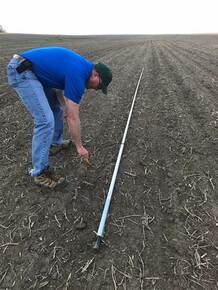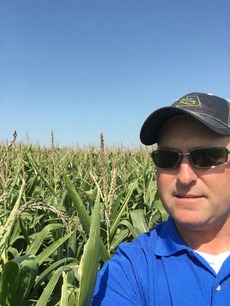Making Decisions Ahead of Busy Planting Season
Posted: 4/9/2019
 With warmer temperatures, sunshine and drying fields, South Dakota’s farmers are preparing for spring planting. It is also a busy time for ag industry professionals who provide inputs and services to farmers. Mark Salvador, Strategic Accounts Manager for Pioneer based in Sioux Falls, and his team are focused on helping farmers choose the right seed products for their farms.
With warmer temperatures, sunshine and drying fields, South Dakota’s farmers are preparing for spring planting. It is also a busy time for ag industry professionals who provide inputs and services to farmers. Mark Salvador, Strategic Accounts Manager for Pioneer based in Sioux Falls, and his team are focused on helping farmers choose the right seed products for their farms.
As farmers are inspecting, repairing, calibrating and getting farm equipment ready for long hours of operation, people in the seed business are busy staging seed products for delivery and working with growers to ensure the proper placement of corn hybrids and soybean varieties.
Because an entire year’s production and profit often relies on one growing season, the decisions a farmer makes are critical. Farmers typically have a small team of advisors to help with selecting the right seed, crop protection, fertilizer and other inputs for their farm. These can include agronomists, seed or crop protection company representatives, staff of local cooperatives or seed dealerships, as well as independent crop consultants.
“Corn and soybean products are designed for specific growing environments,” said Mark. “Yields can be affected by as much as 30 percent if farmers plant seeds on the acres they were born and bred to perform in. At the same time, planting seeds that aren’t a good fit for that field can easily cost a farmer yield and sap the profit out of an entire field.”
There are a number of factors that farmers take into consideration when choosing seed products, including:
- Each corn or soybean variety has traits that make them suitable to a farmer’s crop rotation or management practices. Things like root strength, plant standability, tolerance to diseases,
 rought, insects and herbicides are important to farmers depending on their management style and geography
rought, insects and herbicides are important to farmers depending on their management style and geography
- Corn and soybean plants have different “maturities,” which is how long it typically takes the plant to reach physiological maturity and be ready for harvest. In northern areas like South Dakota, it is important to plant “shorter season” hybrids because our growing seasons are shorter. Corn hybrids typically reach maturity between 120 and 150 days after emergence.
- Farmers may choose to plant a range of products with different maturities so those crops are ready for harvest at different times in the fall. It is one way to spread the workload during a busy season.
- Each year seed companies launch a number of new varieties and hybrids, so farmers typically plant a combination of new products and older ones that have proven yield and agronomic performance in their areas.
- And, cost is always a major factor. Farmers work with input providers to put together the most cost-effective combination of seeds and other products.
Technologies are allowing farmers to make more informed decisions than ever before, and keep a closer eye on their crops all season long, said Mark.
“Precision Agronomy tools are booming these days! To save money and to do right by the environment, increasingly we see farmers adopting digital production tools such as variable rate seed and fertilizer applications,” he said. “By taking a soil map and overlaying it with historical yield data for that field, we can create personalized prescriptions with exact amounts of fertilizer for each area of the field. We can optimize farm inputs and avoid over-applying plant nutrients like nitrogen, phosphorus and potassium.”
By combining satellite technologies and modeling software, farmers can also make sure that their crops have the nutrients and protection they need during the growing season.
“We now have a tool called “Granular Crop Insights” that can help predict whether a corn crop will have the nutrients needed to make a full crop and also, if we are running short due to extraordinary weather events,” he said. “It provides some advanced warning and an opportunity to rescue a crop if it appears it will run out of groceries!”

Finally, we now have subscription-based farm management software that allows our customers to break down farm profitability right down to the specific field. We will soon be able to see profitability at the individual acre basis. Everything we develop in the precision agronomy space is designed to intensify crop management, optimize inputs, drive continuous improvement (sustainability) and increase profitability.
Mark grew up as the oldest of four siblings on a farm on the high-plains of northeastern Colorado. After graduating fr
om Colorado State University in Fort Collins, he returned to the family farm for a few years before moving to Des Moines to work for Iowa Farm Bureau Federation to work in various aspects of public policy as an advocate for farm and livestock families. He joined DuPont Pioneer and worked for several years in Des Moines, then moved to Sioux Falls four years ago. His wife, Courtney, is a dental hygienist.
“I am passionate about grassroots advocacy, remain a card-carrying member of the Iowa and South Dakota Farm Bureau Federations and the South Dakota Corn Growers Association,” he said. “If and when Courtney and I have spare time, we like to hunt, fish and travel.”
He works with a team of sales and agronomy professionals in South Dakota, and is one of more than 20,000 employees that work for the agricultural division of DowDuPont, which is known as Corteva AgriScience.
“While there are almost twenty of us working as staff in the South Dakota seed and crop protection businesses, we have nearly two sales agencies per county across the same geography,” he said.
In addition, a research station in Volga, South Dakota, is seven years old. Scientists work to develop seed products that are suited specifically for the region’s climate and soil types.

Comments
blog comments powered by Disqus